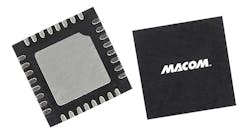This file type includes high resolution graphics and schematics when applicable.
Broadband frequency coverage in an amplifier means that one amplifier can serve many purposes, even for applications requiring coverage of a continuous frequency range, such as in test equipment. The models MAAP-011247 and MAAP-011248 GaAs pHEMT amplifiers from MACOM Technology Solutions are two such components, distributed power amplifiers with broad frequency range of DC to 22 GHz, with the kind of bandwidth where one amplifier can nearly do it all.
As reported recently at the 2016 EDICON US exhibition, these two distributed amplifiers are not only broadband enough to cover a host of different applications, they can also function as either driver amplifiers or power amplifiers in low-power applications. Both amplifiers are matched to 50 Ω across their 22-GHz bandwidths and both maintain consistent performance at all frequencies. For example, in spite of the extremely wide bandwidth, the model MAAP-011247 amplifier provides flat gain with little deviation: typically 12.0 dB at 2 GHz, 11.5 dB at 12 GHz, 12.0 dB at 18 GHz, and 11.5 dB at 22 GHz. Likewise, the output power at 1-dB compression is nominally +30 dBm (1 W), hitting +30 dBm at 2 GHz, +31 dBm at 12 GHz, +30 dBm at 18 GHz, and +28 dBm at 22 GHz.
When slightly less output power is needed (with correspondingly less power consumption), model MAAP-011248 also covers the frequency range from dc to 22 GHz but with typically +30 dBm (1 W) output power at 1-dB compression. Its output power remains within a 3-dB window, with output power at 1-dB compression of +28 dBm at 2 GHz, +30 dBm at 12 GHz, +27 dBm at 18 GHz, and +27 dBm at 22 GHz. The gain is quite flat with frequency, with gain of 12.0 dB at 2 GHz, 12.5 dB at 12 GHz, 13.0 dB at 18 GHz, and 13.0 dB at 22 GHz. The saturated output power is fairly level with frequency, with +31 dBm at 2 GHz, +33 dBm at 12 GHz, +32 dBm at 18 GHz, and +30 dBm at 22 GHz. The PAE for the MAAP-011248 is 17% at 2 GHz, peaking at 25% at 12 GHz, and back to 17% at 18 GHz, and falling to 13.5% at 22 GHz. These PAE values are based on a bias supply of +12 V dc and 400 mA current. The amplifier can also operate on +10 V dc and 400 mA but with slightly less PAE. As with the 2-W MAAP-011247 distributed amplifier, the MAAP-011248 is available in die form and in a 32-lead, RoHS-compliant 5 × 5 mm AQFN package.
These broadband amplifiers can meet many requirements with low-voltage supplies and fairly efficient operation. The amplifiers are well matched, with input and output return loss of typically 15 dB when measured with +20-dBm input power. Both amplifiers are designed integral temperature-compensated output-power detector to maintain level output power across a broad operating temperature range of -40°C to +85°C.



